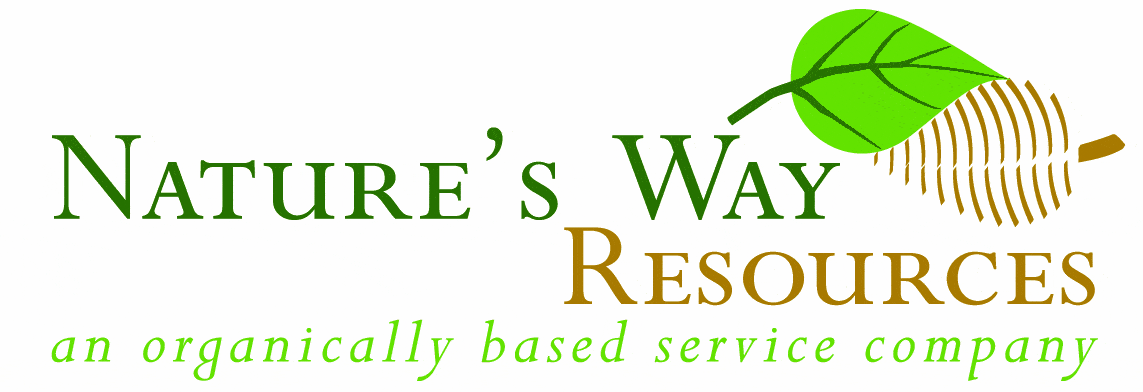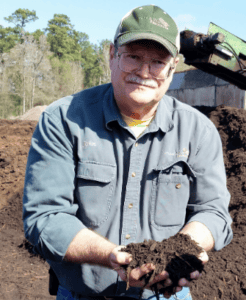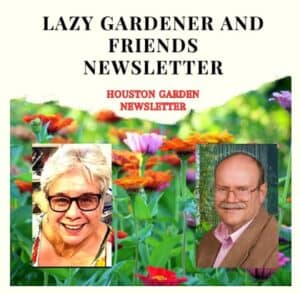 Nature’s Way Resources is proud to produce & email you this free weekly newsletter. We have no ads, but sponsors do graciously help support this project as a public service. Please note their names below & show your gratitude for this free service by patronizing their businesses! To become a sponsor, call (936) 273-1200
Nature’s Way Resources is proud to produce & email you this free weekly newsletter. We have no ads, but sponsors do graciously help support this project as a public service. Please note their names below & show your gratitude for this free service by patronizing their businesses! To become a sponsor, call (936) 273-1200
Nature’s Way Resources owner John Ferguson, “The Lazy Gardener” Brenda Beust Smith and Pablo Hernandez welcome your feedback and are so grateful to the many horticulturists who contribute their expertise
Click here to join our email list
CLICK HERE for PDFs OF PAST LG&F NEWSLETTERS
“Butterflies are nature’s angels.
They remind us what a gift it is to be alive.”
— Robyn Nola

Above, live monarchs provide models for sculptor Michelle Matthewswho is creating huge ones for multi-organization project at Houston Arboretum
Houston Arboretum & Nature Center
MANY TAKING ACTION TO STOP
LOSS OF MONARCH BUTTERFLIES
BY BRENDA BEUST SMITH
“HOUSTON MONARCH STORY” — an inspiring project for all gardeners interested in planting to help slow or halt the loss of these rapidly-disappearing treasurers is now open to the public.
Inspired by the need to support Monarch butterflies on their migratory path through Texas, Houston Arboretum & Nature Center — home to over 600 native plant species, puts these natural treasures in the spotlight with help of larger-than-life Monarch sculptures created by artist Michelle Matthews (pictured above).
Examples of some of the native plants that can be seen near the Houston Monarch Story installation include:
- Acmella oppositifolia – Oppositeleaf Spotflower
- Asclepias incarnata – Swamp Milkweed
- Asclepias perennis – Aquatic Milkweed
- Asclepias virdis – Green Milkweed
- Coreopsis lanceolata – Lanceleaf Coreopsis
- Engelmannia peristenia – Engleman daisy
- Liatris pycnostachya – Prairie Blazingstar
- Penstemon tenuis – Gulf Coast Penstemon
- Salvia azurea – Giant Blue Sage
- Tecoma stans var. angustata – Yellow Bells
Next week: a picture of all these with IDs to use on flash cards.
Neat project for kids: flash cards with pictures (with leaves!)
Even better, leaves & flowers on separate cards to identify/match.
Warning: Not all might be in bloom yet. But will be by summer!)
MICHELLE MATTHEWS’ extraordinary larger-than-life Monarch sculptures, “The Houston Monarch Story,” is displayed in Houston Arboretum’s coastal prairie restoration area, allowing visitors to explore connections between Monarchs and their native habitat. Free admission 7am–dusk daily. Entrances: 4501 Woodway Dr. or 120 W. Loop North Frwy.
TIP O’ THE TROWEL also to key supporters Green Mountain Energy Sun Club, University of Houston Coastal Center, Texas Master Naturalists – Galveston Bay Area Chapter and the Cynthia Woods Mitchell Center for the Arts, whose contributions help ensure a thriving habitat for Monarchs and other pollinators.
- History of the Houston Monarch
- Houston Monarch Story at the Houston Arboretum
- HOUSTON ARBORETUM & NATURE CENTER, 4501 Woodway Dr. – 713.681.8433

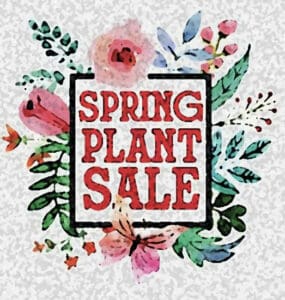 HAVE YOU CHECKED OUT all the Plant Sales in our CALENDAR OF GARDENING EVENTS below? 2025 has to be setting an all-time record for these. In 50+ years of writing this column, I’ve NEVER seen so many. What’s even more wonderful, most also post their inventories online WITH PICTURES. So please don’t ignore those website links!’
HAVE YOU CHECKED OUT all the Plant Sales in our CALENDAR OF GARDENING EVENTS below? 2025 has to be setting an all-time record for these. In 50+ years of writing this column, I’ve NEVER seen so many. What’s even more wonderful, most also post their inventories online WITH PICTURES. So please don’t ignore those website links!’
Even if you can’t attend all you’d like to, the pictures will open your gardening to a whole world of newly-introduced and old favorites of sponsoring plant societies, gardens and clubs, ALL nonprofits focused on making better gardeners of us all!
- HAVING ANGER ISSUES? Rage gardening is a gardening technique that involves using anger to get things done in the garden. Slashing at weeds, pummeling dirt clods, and blasting your water house is said to help relieve stress by channeling frustration into physical labor — a great stress-reliever that’s both mindful and productive. google.com/search?client=firefox-b-1-d&q=rage+gardening
- IF YOU HAD SNAIL problems last year, don’t feel alone. Nationwide, snails and slugs won top honors for being the “Worst Garden Pests of 2024.” One reason in our area: so wet! But Houston ALWAYS has wet seasons. One solution: banana peels that can actually be used as a trap to catch them. Snails and slugs are attracted to the banana’s sweetness but find the peel itself difficult to digest, effectively deterring them from eating it. The texture of a banana peel is not suitable for a snail’s feeding habits, making it unappealing and a deterrent. Ironically, gardeners often use banana peels as bait to attract and collect (for disposal) snails in a designated area!
- No slug/snail problems. Instead of throwing away peels, bury them in your soil. Rich in potassium, calcium, and magnesium, banana peels make excellent natural fertilizer. They also repel pests like aphids and snails, keeping your plants safe.
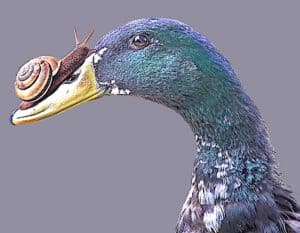 LOVE IT when JOHN FERGUSON comments on my column! Listen UP! “The most effective (and lowest cost) slug and snail control I have ever used is baby ducks. For many years I would go to Wabash Antiques and Feed on Washington and buy a couple baby ducks and keep them in my backyard …They love to eat slugs and snails and will
LOVE IT when JOHN FERGUSON comments on my column! Listen UP! “The most effective (and lowest cost) slug and snail control I have ever used is baby ducks. For many years I would go to Wabash Antiques and Feed on Washington and buy a couple baby ducks and keep them in my backyard …They love to eat slugs and snails and will
almost fight over whom gets to eat them. They will stick their beaks into every nook and crevice looking for them.
The ducks then leave a nutrient rich duck poop behind to fertilize the plants.
When they were old enough, they would just fly off over the fence and be gone. However, they knocked back the slug and snail populations so much that they were no longer a problem often giving me two years of control! As a side benefit, they also eat lots of other pest insects, mulberries that dropped from my tree, some weeds, etc. turning them all into rich poop.
God knew what he was doing by providing a natural pest control that enriches the soil in the process. A modern gardener studies nature and copies how pest control is done. It works better, costs less, and no toxic side effects. In other words what has become known as “Organic Methods”.
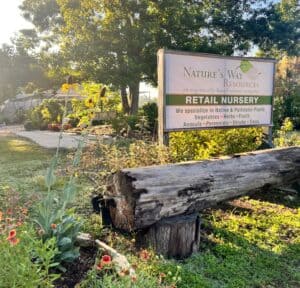 ATTN. GARDEN/PLANT GROUPS — In wake of Hurricane Beryl, Nature’s Way Resources offers free guided tours of NWR’s extensive nursery/soil/mulch facilities for garden clubs, plant societies and other plant-oriented, organized groups. As usual, NWR’s now-expanded meeting site is free to above groups. Reservations a must for both.
ATTN. GARDEN/PLANT GROUPS — In wake of Hurricane Beryl, Nature’s Way Resources offers free guided tours of NWR’s extensive nursery/soil/mulch facilities for garden clubs, plant societies and other plant-oriented, organized groups. As usual, NWR’s now-expanded meeting site is free to above groups. Reservations a must for both.
Brenda Beust Smith’s column is based on her 40+ years as the Houston Chronicle’s “Lazy Gardener” column — lazygardenerbrenda@gmail.com Brenda’s column focuses ONLY on the Greater Houston Area
John’s Corner
NEWS FROM THE WONDERFUL WORLD
OF SOIL AND PLANTS
Book Review: THE SIXTH EXTINCTION An Unnatural History
THE SIXTH EXTINCTION An Unnatural History by Elizabeth Kolbert, 10th Edition, Macmillan Publishing, 2024, ISBN: 978-1250887-313 (paper)
Scientists studying the geologic record have found there have been five mass extinctions recorded when the majority lifeforms on earth crashed and disappeared.
An example is when an asteroid hit the area near Yucatan peninsula and wiped out the dinosaurs and many other species at the end of the Cretaceous period. Today species are disappearing at a faster rate than after the asteroid hit the Yucatan.
The era we are now living in is called the Anthropocene, defined by humans being, the most dominant and influential life form the world has ever known. As a result, we are losing species faster (going extinct) than any time in the history of the earth.
The author starts off by discussing previous extinctions and what we know about them from the causes to the results.
The 10th-anniversary edition of the instant classic, The Sixth Extinction, is now with a new epilogue. Kolbert blends intellectual and natural history and field reporting into a powerful account of the mass extinction unfolding before our eyes.
Over the last half a billion years, there have been five mass extinctions, when the diversity of life on earth suddenly and dramatically contracted. Scientists around the world are currently monitoring the Sixth Extinction, predicted to be the most devastating extinction event since the asteroid impact that wiped out the dinosaurs. This time around, the cataclysm is us.
From the publisher:
“In The Sixth Extinction, two-time winner of the National Magazine Award and New Yorker writer Elizabeth Kolbert draws on the work of scores of researchers in half a dozen disciplines, accompanying many of them into the field: geologists who study deep ocean cores, botanists who follow the tree line as it climbs up the Andes, marine biologists who dive off the Great Barrier Reef. She introduces us to a dozen species, some already gone, others facing extinction, including the Panamanian golden frog, staghorn coral, the great auk, and the Sumatran rhino. Through these stories, Kolbert provides a moving account of the disappearances occurring all around us and traces the evolution of extinction as concept, from its first articulation by Georges Cuvier in revolutionary Paris up through the present day. In the ten years since the book was originally published, evidence of the Sixth Extinction has continued to mount, making its message more urgent than ever.
The Sixth Extinction is likely to be mankind’s most lasting legacy; as Kolbert observes, it compels us to rethink the fundamental question of what it means to be human.”
A question gardeners must ask themselves is, “Am I part of the problem or part of the solution.” Do we use toxic chemicals that kill all kinds of life as well as contribute to air and water pollution, global warming, environmental destruction, spread of invasive species, and much more.
Do we leave outside lights on at night that leads to the death of many beautiful moths and other night feeding insects? Do we plant exotic plants that provide no food for our butterflies, bees, hummingbirds, and birds?
All these little things add up to destroy God’s creation.
SPONSORSHIP
If you are interested in becoming a sponsor, please contact us at 936-273-1200 or send an e-mail to: lazygardenerandfriends@gmail.com
ABOUT US
BRENDA BEUST SMITH WE KNOW HER BEST AS THE LAZY GARDENER . . .
- but Brenda Beust Smith is also:
- a national award-winning writer & editor
- a nationally-published writer & photographer
- a national horticultural speaker
- a former Houston Chronicle reporter
When the Chronicle discontinued Brenda’s 45-year-old Lazy Gardener” print column — started in the early ’70s as a fun side-project to reporting, it then ranked as the longestrunning, continuously-published local newspaper column in the Greater Houston area. The name, she says, is not just fun, it’s true.
Brenda’s gradual sideways step from reporter into gardening writing led first to an 18-year series of when-to-do-what Lazy Gardener Calendars, then to her Lazy Gardener’s Guide book which morphed into her Lazy Gardener’s Guide on CD, which she now emails free upon request.
Brenda became a Harris County Master Gardener and, over the years, served on theboards of many Greater Houston area horticulture organizations. She hosted local radio and TV shows, most notably a 10+-year Lazy Gardener specialty shows on HoustonPBS (Ch. 8) and her call-in “EcoGardening” show on KPFT-FM.
For over three decades, Brenda served as Assistant Production Manager of the GARDEN CLUB OF AMERICA’S “BULLETIN” magazine. Although still an active broad-based freelance writer, Brenda’s main focus now is THE LAZY GARDENER & FRIENDS HOUSTON GARDEN NEWSLETTER with John Ferguson and Pablo Hernandez of Nature’s Way Resources.
A native of New Orleans and graduate of St. Agnes Academy and the University of Houston, Brenda lives in Humble, TX, and is married to the retired Aldine High School Coach Bill Smith. They have one son, Blake.
Regarding this newsletter, Brenda is the lead writer, originator of it and the daily inspiration for it. We so appreciate the way she has made gardening such a fun way to celebrate life together for such a long time.
About her column, Brenda says: “I don’t consider myself a ‘garden writer.” I started out 50+ years ago as a very lazy “gardening reporter.” I still feel that way today. I hope my columns inspire/help newcomers, but I do not write to them. I write to very experienced gardeners who want to expand their horizons.
JOHN FERGUSON
John is a native Houstonian and has over 35 years of business experience. He owns Nature’s Way Resources, a composting company that specializes in high quality compost, mulch, and soil mixes. He holds a MS degree in Physics and Geology and is a licensed Soil Scientist in Texas.
John has won many awards in horticulture and environmental issues. For years he represented the composting industry on the Houston-Galveston Area Council for solid waste. His personal garden has been featured in several horticultural books and “Better Homes and Gardens” magazine. His business has been recognized in the Wall Street Journal for the quality and value of their products. He is a member of the Physics Honor Society and many other professional societies. John is the co-author of the book Organic Management for the Professional.
For this newsletter, John contributes articles regularly and is responsible for publishing it.
PABLO HERNANDEZ Pablo Hernandez is the special projects coordinator for Nature’s Way Resources. His realm of responsibilities include: serving as a webmaster, IT support, technical problem solving/troubleshooting, metrics management and quality control. Pablo helps this newsletter happen from a technical support standpoint.
Download the Newsletter with Our Events Calendar Below!
